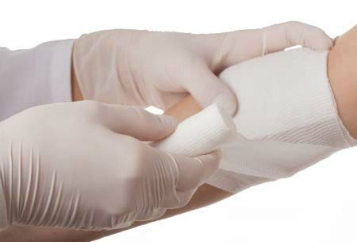Categories
6 Types of Wound Dressings

Be it a minor cut or perhaps a deep incision; it is imperative that you take good care to avoid further complications. Wound care dressing is one of the crucial steps in a healing process. There is no argument over the fact that the types of wound care dressings at your disposal,are numerous. Which one of the options is going to be most suitable for you and how effective is it going to be, depends entirely on the kind of wound that you have received.
A patient who has received a wound due to an injury is recommended for dressing since it prevents complications (e.g. infections) from occurring. Remember that a wound dressing and a bandage are two different terms. The primary is that the wound care dressing being in direct contact while the bandage being used to keep the dressing from displacing only.
Contents
Dressing Types at a Glance
The types of wound, along with the location where it has occurred, and its severity determine the range of purposes that a wound care dressing will serve. Besides reducing the probability of infection, the following are the purposes served by a wound care dressing:
- Preventing the wound from excessive bleeding while promoting the process of clotting for better and more efficient healing
- A wound care dressing helps in the absorption of excess fluids like plasma or blood
- Encourages the process of tissue removal that has been damaged.
- Wound debridement: a typical process to sabotage the action of foreign invaders
Now that you are familiar with the basic concept of wound care dressing let us take a closer look at the types of wound care dressing and the scenarios in which each of them is recommended.

Gauze Dressings
Gauze dressings are recommended for a broad range of patients since these are available in a significant variety of sizes as well as the shapes. It is entirely up to you to opt for a gauze dressing that is made up of woven materials or the non-woven ones. If your wound has already been infected, it is highly recommended to make use of gauze dressing. The majority of health professionals tend to choose gauze dressings for patients with excessively draining wounds, require delicate and careful packing, or are in need of dressing changes more often than usual.
A few of the pros associated with gauze dressings include their convenience of availability and their compatibility with literally any type of a wound. Furthermore, their cost effective nature offers a major perk as compared to the alternatives, a few of which may be beyond the budget of most patients who are (or have been) a victim of a certain type of wound. However, some of the downsides of gauze dressingsinclude a requirement to change the dressing more frequently than usual and the requirement of adjoining the dressing with one of the other types to achieve the desired outcome. Furthermore, the gauze dressing is not recommended in the event of moist wound healing.
Transparent Films
One of the major benefits of using transparent films is that they enable the oxygen to move through the dressing and ultimately reach the wound. In the meantime, it is made possible for the moisture vapour to move through the wound and into the film from where it is released. Polyurethane is quite commonly used as the major constituent of transparent films. According to the experts, transparent films are recommended for wounds including donor sites, partial-thickness, pressure ulcers of both stages I or II, and minor burns.
Transparent films have significant benefits to offer including their built-in quality to keep in place for as long as a week. Moreover, their ability to conform impeccably to the wound, their crucial role in removing the damaged tissue and foreign invaders from the wound, preventing excessive friction that may arise between the dressing and the wound cannot be sidelined. Not only that, but it also enables the healthcare professional to analyse the wound properly without having to remove an entire film. By keeping the wound dry, it plays an indispensable role in avoiding the infection.
It is to be borne in mind at all times, that there are certain implications in which a transparent film must be avoided as the choice of wound care dressing. Such implications may include excessive draining of the wound. Transparent film, as the opted wound care dressing, carries a minor risk of sticking to the wound. Although it rarely happens and that too, in the case of a few particular injuries. Furthermore, an added complication of periwound maceration may also be associated with the use of transparent films because of their occlusive nature.
Foams
Foam dressing is the most suitable option in an event where the risk of dressing getting stick to a minor cut or an incision is quite high. The foam dressings are usually made up of a gel that is coated with a film as suggested by the name, or polyurethane is also widely used as it has a hydrophilic nature. A few of the common implications in which foam dressings are recommended as the choice of wound care dressing include minor burns, pressure ulcers, diabetic ulcers, skin grafts, venous ulcers, and donor sites.
Foam dressings are one of the most comfortable types available at the disposal of an unfortunate victim of the wound. Not only do they offer a highly absorbent nature, but they further prevent adherence of dressing to the wound bed as well. Depending on the quantity of wound exudate, the number of dressing changes required in the case of foam dressings is quite less, as compared with other dressings. This very type of dressing is available in a wide range of shapes as well as sizes to meet particular requirements of the wound and patient.
A few of the common downsides to foam dressings include the requirement of a separate dressing that keeps it in place, failure to change the dressing on time may lead to periwound maceration. It is not recommended for wounds that are not excessively draining or the ones with eschar. Furthermore, as per the professional opinion, it would rather be a commendable idea to avoid using foam dressings in the event of an infectious wound, or the one that is tunnelling.
Hydrocolloids
If the high rate of absorption is a sheer requirement, hydrocolloid wound care dressing is going to be the optimum solution. Thanks to gelatin, methylcellulose, pectin, and a few other colloidal particles which have enabled this dressing to possess an indigenous quality of swelling and forming a gel as soon as it makes contact with the exudate. A firm adhesive backing is another common feature that makes it more useful for the victims. Most, if not all, of the medical practitioners, will make use of the hydrocolloids dressing in the case of venous ulcers, burns, and pressure ulcers.
Hydrocolloids wound care dressing has numberless advantages. A few of the accentuated benefits include insulation of the wound bed, autolytic removal of the damaged tissue and infectious invaders, and impermeability for bacteria, stool, or urine. Last but not the least, this dressing offers optimum absorption of exudate that is neither excessive nor too low to have an impact in the first place.
Since the hydrocolloid dressings are known to leave the wound bed with residual particles, these are often diagnosed as an infection of the wound. It is difficult to keep such a wound care dressing in place, and there is a potentially accentuated risk of it moving to other parts of the body, specifically the ones which are under an impact of friction. Lastly, it is advised to refuse the hydrocolloids treatment for a given type of wound if the wound has already been infected.
Alginates
For anyone with a background in marine biology, it is a widely known fact that some brown seaweed species have ample amounts of salts which can be extracted for various purposes. Alginates are the kind of wound care dressings which are essentially derived from the salts found in these species. Alginates dressings are available in the form of woven as well as non-woven alternatives. Similar to the hydrocolloids, alginates do also have an indigenous capacity to turn into a gel-like mass as soon as they come in contact with exudate. It is a known practice amonghealthcare providers to make use of the alginates dressings in the event of wounds which are oozing out a lot of exudates, venous ulcers, and the wounds which have started to show the signs of tunnelling.
The non-adherent nature of dressing is what makes it highly useful in the patients who are suffering from a wound that has already been infected. Alginates dressings are highly absorbent and promote the autolytic removal of damaged tissue just like a few other types of wound care dressings listed above.
Some of the common complications which make it difficult for the alginates dressings to be used include the wound bed desiccation. Such dressings are almost never functional without the use of a secondary dressing. Lastly, the tendons, or perhaps even the bone or capsule that have been exposed, are put at a higher risk of drying.
Composites
Composite, as the name implies, is primarily a combination of different types of dressings. It is commonly used as the primary as well as secondary dressing. A wide range of combinations can be used to make a composite wound care dressing. But more often than not, a combination of gauze dressing and a dressing that is capable of retaining the moisture is used to make one. Since it is a mix of different dressings, it is compatible with pretty much all kinds of wounds.
While there may be other benefits associated with the use of composites as wound care dressings, the major reason behind its widespread utilisation is the convenience of availability as well as its utilisation. Not only are they readily available to clinicians, but are also the simplest ones to use on patients with minor or major wounds.

It would certainly be a bad decision to opt for a composite if budget happens to be your major concern since composites usually cost a lot more as compared to the other prominent types of wound care dressings mentioned in the list above. It is also indispensable to mention here that storing a composite is relatively more difficult if we compareit with any other kind of this niche.
It should go without saying that those mentioned above are only a fraction of the wound care dressings available to be used with major or minor wounds and injuries. While these may be the most prominent ones or the most widely used dressings for wounds, a few of other options at your disposal include the biosynthetic dressings, which contain certain antimicrobials or silver, and the charcoal dressings.
Conclusion
While it is entirely up to the healthcare provider to determine the kind of wound care dressing that will be most suitable for the type of wound that you have, it is always a commendable idea to have the fundamental information about the kinds of dressings and how each of them functions to promote the efficient healing of wound along with its protection against a wide array of infections. Now that you are aware of a few of the prominent aspects of each of these dressings, you are in a much better position to take a better care of your particular wound. This will enable you to achieve the goals of reducing pain, mobilise the part of your body that has been injured, apply the required amount of pressure in the event of venous stasis or haemorrhage, enable moist wound healing, and keep the wound from being infected. Remember, a little effort into knowing your wound can save you a lot of complications in the future.



